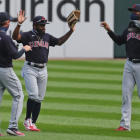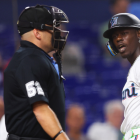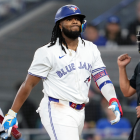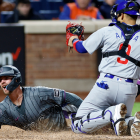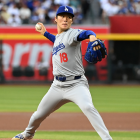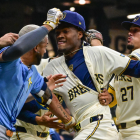
The 2020 MLB season is more than three weeks old and, unfortunately, the headlines have been dominated by COVID-19 outbreaks rather than dingers and pitching performances. Twenty-one members of the Marlins' traveling party, including 18 players, tested positive earlier this month. Nine Cardinals players and seven staffers have tested positive as well.
On the field, the 60-game season is roughly 25 percent complete and the "it's still early" excuse doesn't apply like it normally does three weeks into the season. Every game carries that much more importance in a short season. Last week we examined Aaron Judge's newfound tendency to pull the ball, among other things. Now let's look at three more early season trends.
Cleveland's outfield in need of an upgrade
Several weeks ago, in these very internet pages, we noted Cleveland had one of the least productive outfields in baseball last season. The outfielders combined to hit .253/.318/.417 in 2019 and ranked 24th in OPS+ and 19th in WAR. The outfield wasn't a total disaster but it certainly wasn't as asset. There was room for improvement abound.
Cleveland allowed deadline rental Yasiel Puig to leave as a free agent -- Puig is still unsigned and could return, I suppose -- and otherwise did little to improve the outfield over the winter. The team brought in Domingo Santana, who had been non-tendered by the Mariners, and that's about it. The hope was Bradley Zimmer and Tyler Naquin would stay healthy and help the club.
Eighteen games into the 2020 season, Cleveland is 10-8, Naquin missed time with injury (again), and their outfielders are doing this:
- Batting average: .152 (30th in MLB)
- On-base percentage: .277 (27th in MLB)
- Slugging percentage: .218 (30th in MLB)
- OPS+: 39 (30th in MLB)
- WAR: minus-0.5 (29th in MLB, better than only the Pirates at minus-1.1)
Yikes! The infield isn't doing much better -- Cleveland's infielders are hitting .194/.318/.283 this year, prompting Francisco Lindor to jokingly tell reporters, including Cleveland.com's Paul Hoynes, "They could throw a rosin bag right now and I'd probably pop it up" -- but the team at least has high-end talent on the infield (Lindor, Jose Ramirez, etc.). That is not the case in the outfield. Look at this:
| PA | AVG/OBP/SLG | OPS+ | 2B | HR | WAR | |
|---|---|---|---|---|---|---|
29 | .038/.138/.154 | -19 | 0 | 1 | -0.2 | |
44 | .119/.159/.119 | -21 | 0 | 0 | -0.2 | |
Domingo Santana | 44 | .171/.341/.286 | 76 | 1 | 1 | 0.1 |
Bradley Zimmer | 39 | .207/.385/.310 | 96 | 3 | 2 | 0.1 |
Luplow annihilated lefties last season (.320/.439/.742) and is 0 for 10 against them this season. Mercado's strikeout has nearly doubled from his impressive rookie campaign a year ago (17.4 percent to 29.5 percent). Zimmer's on-base percentage is propped up by four hit by pitches. He had five in 460 MLB plate appearances prior to 2020, so this isn't some Anthony Rizzo-esque skill.
Cleveland is 10-8 through 18 games because the pitching, particularly the starters, have been out of this world. The starters lead baseball with a 2.24 ERA and a 5.15 K/BB ratio. Even with Zach Plesac and Mike Clevinger taking themselves out of commission for a bit with their selfishness, the club has the pitching depth to remain among the league's elite staffs.
The offense, clearly, needs a jolt. It's not unreasonable to assume Lindor and Carlos Santana will turn things around (Santana leads MLB with 24 walks but otherwise isn't hitting). The outfielders probably aren't truly this bad but it's not safe to expect the team to snap out of it a la Lindor and Santana. Those guys have long track records. The outfielders do not (except Domingo Santana, I suppose).
The Aug. 31 trade deadline is less than three weeks away -- I honestly have no idea what to expect at the deadline, it could be busy or it could be slow and neither would surprise me -- and with the club firmly in the mix for an expanded postseason spot, I have to believe Cleveland will be in the market for outfield help. A few possibilities:
- Corey Dickerson, Marlins: An underrated and consistent hitter who has turned himself into a solid defender. Just a total pro in the box. Dickerson is owed $8.75 million next season, which could be an issue for small market Cleveland.
- Clint Frazier, Yankees: The former Cleveland prospect is capital-B Blocked in New York. If not Frazier, then perhaps Miguel Andujar, who has taken to the outfield surprisingly well? A young bat for a young arm trade seems plausible.
- Shin-Soo Choo, Rangers: Choo is in the final year of his contract and the Rangers have started slow, plus he has a history with Cleveland. I kinda love it. Money could be an obstacle (Choo's owed approximately $5.7 million the rest of 2020.)
- Mike Yastrzemski, Giants: Hey, why not? The Giants are rebuilding and may be willing to cash Yastrzemski, who turns 30 later this month, in as a trade chip while his value is at its highest. He'd fit well on the field and on the payroll.
Cleveland is averaging 3.33 runs per game, second fewest in baseball, and it has scored no more than two runs in 11 of its 18 games. As good as the pitching is -- and it is great -- it's awfully hard to win when you struggle to cobble together three runs a night. The offense needs an upgrade and the outfield is the most obvious (and easiest) place to make it.
"I feel like we have enough talent to get out of it," first base coach Sandy Alomar told reporters, including Hoynes, earlier this month. "What we don't want is our pitching to feel the pressure. I feel like our pitchers need to understand that they have to keep executing and keep pounding the zone one pitch at a time, not worrying about what the score is ... At the end of the day, it's a short schedule, 60 games, and right now we're in a rough spell, but I believe the guys are gonna get out."
Promising arms emerging in Toronto bullpen
A strange season this has been for the Toronto Blue Jays. Because they were essentially kicked out of Canada amid COVID-19 concerns, the Blue Jays have played "home" games at Nationals Park and Buffalo's Sahlen Field, and they sat idle last weekend because their scheduled opponent (Phillies) was locked down. I do not envy the nomad Blue Jays this year.
Toronto is 6-8 through 14 games, which isn't surprising given their status as a rebuilding team. Vladimir Guerrero Jr. still can't elevate the ball and promising youngsters like Cavan Biggio and Danny Jansen have started slow as well. Free-agent additions Hyun-Jin Ryu and Tanner Roark have an underwhelming 4.50 ERA combined. It's been a grind early on, for more reasons than one.
Truth be told, the most positive Blue Jays development this season has come on the mound. The bullpen, even with closer (and impending free agent) Ken Giles going down with an elbow injury during the season's first weekend, has been very good overall, pitching to a 3.60 ERA with a 26.4 percent strikeout rate. Three relative newcomers have stood out:
| G | IP | H | R | ER | BB | K | HR | |
|---|---|---|---|---|---|---|---|---|
LHP Ryan Borucki | 4 | 4 | 1 | 0 | 0 | 2 | 9 | 0 |
LHP Anthony Kay | 3 | 8 | 5 | 1 | 1 | 1 | 8 | 1 |
RHP Jordan Romano | 8 | 8 | 0 | 0 | 0 | 3 | 11 | 0 |
Total | 15 | 20 | 6 | 1 | 1 | 6 | 29 | 1 |
Those three plus fill-in closer Anthony Bass (who blew the save Tuesday night) have given manager Charlie Montoyo a surprisingly potent late-inning relief crew early this season. Romano, 27, allowed 14 runs in 15 1/3 innings during his MLB debut last year but has emerged as Bass' primary setup man this year thanks in part to a new pre-pitch squat that helps him focus.
"I really feel like when I go down into that squat position and come back up, that's me being ready to throw," Romano recently told reporters, including Sportsnet's Arden Zwelling. "It separates each pitch from one another. It really helps me lock in that pitch. That's something I wanted to be better at this year, making each individual pitch and not thinking about the last one as much."
"I've played with Jordan a long time and you can just tell he's evolving mentally on how he's going to attack," Jansen told Zwelling. "He's just a different dude. I think he understands himself better now. Obviously, he's performing and he's been spectacular. But I think the mentality that he has coming into it. He's a different guy. It's a scary dude out there right now."
Borucki, 26, debuted as a starter in 2018 and was quite good (3.87 ERA) as a stereotypical crafty lefty, but injuries limited him to 6 2/3 innings in 2019, and the Blue Jays stuck him in the bullpen this year. His velocity has jumped nearly 2 mph in relief:
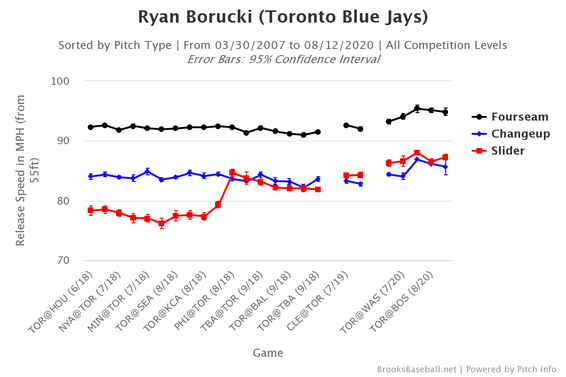
"Mentality wise, (the bullpen) is way different for me," Borucki recently told reporters, including the Toronto Star's Gregor Chisholm. "I'm more of a finesse starter, really try to get ground balls and stuff like that. Now it's just coming in with my best stuff and whatever is working that day I'm going to go with ... It's fun. It fits my personality a little bit. I like competing against guys, me against him, just seeing who gets the best of one another."
The 25-year-old Kay joined the Blue Jays in the Marcus Stroman trade last year and took his lumps in three big league outings, allowing nine runs in 14 innings after the trade. He was squeezed out of the rotation in summer camp but made the team as a reliever, and has become a multi-innings weapon for Montoyo. Kay's thrown at least two innings in all three appearances.
"(Pitching out of the bullpen is) something I'm comfortable with," Kay told reporters, including MLB.com's Keegan Matheson, early in summer camp. "I haven't done it in a couple of years but, ultimately, if that's what they want me to do on this team to be up with the big league team, I'm willing to do it."
MLB.com ranks Kay as the 11th best prospect in Toronto's system and says he "has the potential and the stuff to eventually settle in as a mid-rotation-type starter." It's too soon to relegate him to a full-time relief role, I believe, but there is something to be said for learning to get outs at the MLB level regardless of role. Kay would hardly be the first pitcher to have success in the bullpen before transitioning back into the rotation.
Romano was a reliever in college who flopped as a starter in the low minors before shifting back to the bullpen. He's right where he belongs. As for Borucki, the improvement in his stuff combined with his injury history leads me to believe the bullpen is the best spot for him. There's no shame in being a high-leverage reliever these days, and it's hard to argue with the results. Borucki's a different animal in relief.
Even with a few young hitters struggling in the early going, the Blue Jays are inching in the right direction with their rebuild, and it appears a few bullpen building blocks are emerging this year. Romano's adjustments and Borucki's improved stuff are tangible reasons to believe in their success. If Kay doesn't stick as a starter, he's hinted at bullpen usefulness as well. Those are all good signs for a young team in need of arms.
Yandy grounded more than ever
In the Statcast era, few players jump off the page as much as Tampa Bay Rays corner infielder Yandy Diaz. The 29-year-old has a bodybuilder's physique and the exit velocities to match. With Cleveland from 2017-18, Diaz posted a 91.8 mph average exit velocity, well above the 87.9 mph league average and 16th highest among the 500 players with at least 100 batted balls those two years.
The problem: Diaz didn't turn the exit velocity into results because he hit the ball on the ground too often (56.6 percent ground ball rate from 2017-18). He slugged .366 those two years with Cleveland and his career .432 slugging percentage in Triple-A suggested there wasn't much power to come. Hitting the ball hard is very good! Hitting the ball hard on the ground is less good though.
The Rays identified Diaz as someone who had another level to his game if they could help him add loft to his swing. They acquired him in Edwin Encarnacion/Carlos Santana three-team trade with Cleveland and the Mariners, went to work on his swing, and were rewarded with a .267/.340/.476 batting line and 14 home runs in 79 games in 2019. Diaz went deep twice in the Wild Card Game.
More than anything, the Rays helped Diaz learn to pull the ball rather than get it airborne. His 50.8 percent ground ball rate last year was still too high for a guy with his hard contact ability, though his 33.2 percent pull rate was far more conducive to power than the 26.4 percent pull rate he posted with Cleveland. An opportunity and some swing changes can go a long way.
Diaz turned 29 this past weekend and he was expected to take another step forward and cement himself as a middle of the order masher for a contending Rays team in 2020. Instead, he's been among the least productive hitters in baseball early on, going 13 for 56 (.228) with only two extra-base hits (both doubles). Thirteen walks against 10 strikeouts is really good. The power hasn't been there though.
Usually 70 plate appearances early in the season grab your attention but aren't necessarily a cause for concern. In Diaz's case, two red flags exist. One, his exit velocity is way, way down. His average exit velocity is only 87.0 mph, down from 91.7 mph last year. His hard-hit rate (percentage of batted balls at 95 mph or better) has dropped from 44.8 percent to 25.5 percent.
And two, Diaz is beating the ball into the ground more than ever. His 70.2 percent ground ball rate is highest among the 166 hitters with enough plate appearances to qualify for the batting title and his minus-10.2 degree launch angle is astoundingly bad. Zack Britton, arguably the greatest ground ball pitcher of his generation, held hitters to an MLB low minus-8.4 degree launch angle last season, for reference.
Here is a heat map of Diaz's balls in play this season. It looks like it belongs to a right-handed singles hitter like Derek Jeter, not a guy with a reputation for punishing the ball like Diaz.
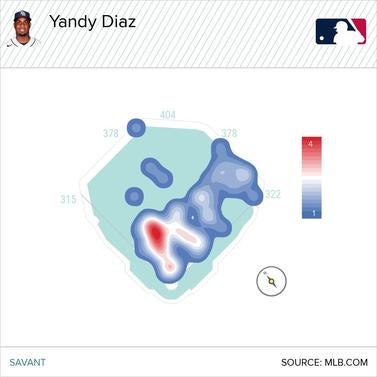
The decline in exit velocity and increase in ground balls suggest Diaz is either in a mechanical funk at the plate or he's injured (or both, I suppose). He's started 16 of the team's 18 games and there's no indication he's hurt -- it's possible Diaz is banged up and playing through something and we don't know about it -- so a mechanical issue is the more likely explanation.
Tampa Bay has a tremendous pitching staff but they are not blessed with a great offense -- they're averaging 4.50 runs scored per game, exactly the MLB average -- and Diaz was expected to be an important part of the lineup. Heck, he's batted first, second, or third in all 16 starts this year. The Rays need Diaz to get on track, and to do that he has to start hitting the ball harder (which he's always done) and he has to get the ball airborne (which he's done in spurts). This version of Diaz won't work.















